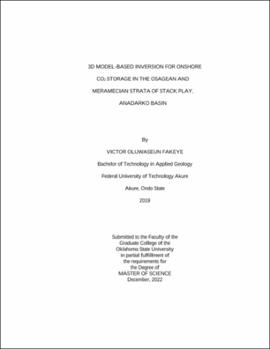| dc.contributor.advisor | Knapp, Camelia C. | |
| dc.contributor.author | Fakeye, Victor Oluwaseun | |
| dc.date.accessioned | 2023-08-02T19:47:04Z | |
| dc.date.available | 2023-08-02T19:47:04Z | |
| dc.date.issued | 2022-12 | |
| dc.identifier.uri | https://hdl.handle.net/11244/338773 | |
| dc.description.abstract | Depleted hydrocarbon reservoirs can store some amount of supercritical CO₂ depending on their reservoir properties. An understanding of these properties is therefore imperative for an assessment of the CO₂ storage potential of these reservoirs. The seismic reflection survey method, with its extensive use over the years, has gained prominence over other geophysical methods in providing an image of the subsurface to depths extending thousands to hundreds of thousands of feet. However, seismic reflection data are sometimes ambiguous and non-unique, hence the need for seismic inversion. Unlike the conventional seismic section which provides data based on the properties of the interface, seismic inversion provides information based on the properties of the rock. The seismic inversion methods incorporate the use of well logs - particularly sonic and density logs, and seismic data, from which lithology can be delineated and porosity extracted. Porosity and permeability are physical properties of rocks that determine how well a reservoir performs, and how much fluid can be stored in a rock formation. | |
| dc.description.abstract | The Osagean and Meramecian strata, informally known as the “Mississippi Lime”, constitute part of the STACK play in the Anadarko Basin. These formations were assessed for their CO₂ storage capacities by carrying out a post-stack, model-based inversion on available seismic data. The inverted seismic volume was transformed to predict porosity distribution by applying an empirical relationship derived from crossplotting the acoustic impedance model and porosity measurements taken from the wells. Porosity-permeability relationship was established to assess the spatial distribution of permeability across the study area. Taking other parameters into consideration, storage capacities of 79.81 Mt and 7.3 Mt were estimated for the Meramecian and Osagean formations respectively. | |
| dc.format | application/pdf | |
| dc.language | en_US | |
| dc.rights | Copyright is held by the author who has granted the Oklahoma State University Library the non-exclusive right to share this material in its institutional repository. Contact Digital Library Services at lib-dls@okstate.edu or 405-744-9161 for the permission policy on the use, reproduction or distribution of this material. | |
| dc.title | 3D model-based inversion for onshore CO₂ storage in the Osagean and Meramecian strata of STACK play, Anadarko Basin | |
| dc.contributor.committeeMember | Knapp, James H. | |
| dc.contributor.committeeMember | Pashin, Jack C. | |
| osu.filename | Fakeye_okstate_0664M_17965.pdf | |
| osu.accesstype | Open Access | |
| dc.type.genre | Thesis | |
| dc.type.material | Text | |
| dc.subject.keywords | Anadarko Basin | |
| dc.subject.keywords | carbon storage | |
| dc.subject.keywords | Meramecian | |
| dc.subject.keywords | seismic inversion | |
| dc.subject.keywords | STACK play | |
| dc.subject.keywords | unconventional reservoirs | |
| thesis.degree.discipline | Geology | |
| thesis.degree.grantor | Oklahoma State University | |
